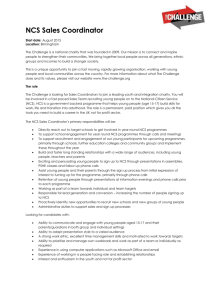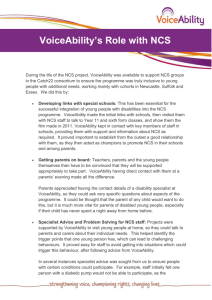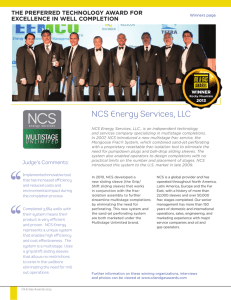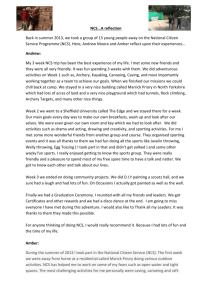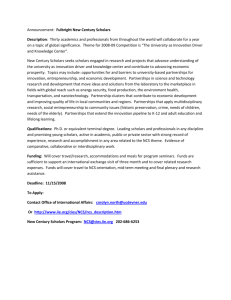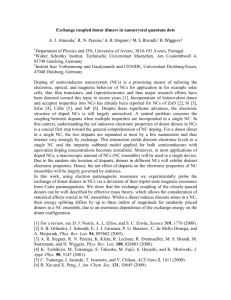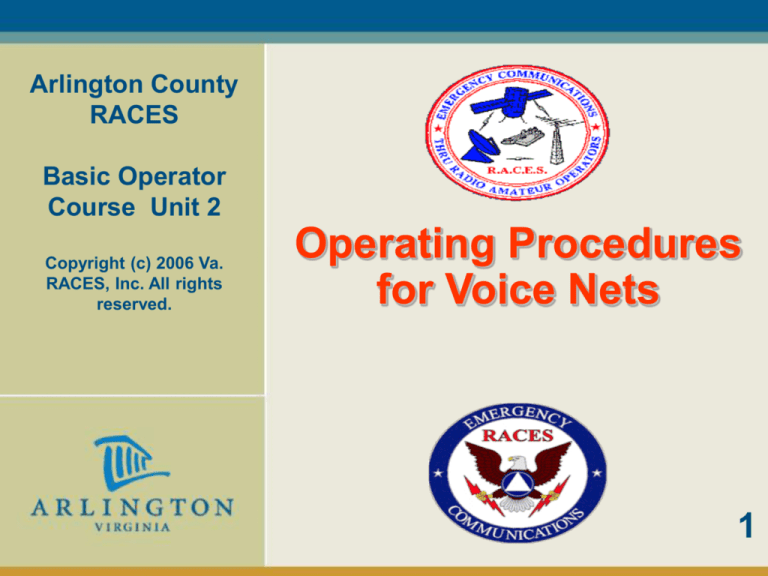
Arlington County
RACES
Basic Operator
Course Unit 2
Copyright (c) 2006 Va.
RACES, Inc. All rights
reserved.
Operating Procedures
for Voice Nets
1
Objectives:
You will be able to demonstrate or explain:
Why we use a directed net
Net Control Station’s Role
Keeping an NCS log
Starting the Net and Checking in
Operating practices used by RACES
Voice communications procedure
Procedural words and phonetics
2
A DIRECTED NET …
Means Net Control requires stations to
get permission before using the net.
Is recommended whenever more than 4
stations share the same frequency.
Enables the NCS to prioritize and
handle multiple stations with traffic.
Every RACES operator should know
how to call up and run a net !
3
The Goal of Net Control is to …
PREVENT CHAOS!
So Plan Ahead.
Ensure that there is ALWAYS an
alternate Net Control in case you must
go off the air!
– Battery goes dead
– Thunderstorm activity
– Any unforeseen or dangerous situation
4
NET CONTROL STATION’S JOB IS :
CONTROL the net
MAINTAIN net discipline
– by setting the example
MOVE traffic efficiently
TRACK what’s going on…
RECORD what happens...
REPORT to Team Leader, Radio
Officer, served agency contact.
5
NCS Location and Operations
NCS Should NOT operate from an EOC or
Command Post
– Noisy / distracting - to you and agency officials
– Get a safe, quiet place, with room to operate
– Plan for antennas and power supplies
NCS Should ALWAYS make sure:
–
–
–
–
Equipment & antennas are in good order
Batteries are charged, inspected regularly
To use minimum reliable power, so batteries last
To be on time, and at the correct frequency!
6
As NCS, You MUST write things down!
Because you won’t remember
everything when it gets busy!
Nor can you brief your relief operator
from memory...
Or reconstruct what happened later...
And make an accurate report.
7
NCS Log
Served agencies usually REQUIRE:
Formal logs (ICS Form 309 )
Status boards (follow Agency SOP)
These are used for:
– Asset tracking
– Personnel Accountability Reports
(sometimes called “PAR-checks”)
– Part of the official incident record.
8
What goes into an NCS log? -1
Date, time, frequency
Who originated the traffic, who took it?
– Who gets reply when it comes back?
– Frequency / mode to be used for
reply?
What was the assignment or action?
No. of pieces, destination, PRIORITY:
ICS = URGENT, IMMEDIATE, R (ROUTINE)
Where? Local Vs. “Through”
9
What goes into an NCS log? -2
How?
– Band? Mode? (FM, digital, SSB, CW)
– Routing? Which BBS, node, net?
– Note use of relays or alternate frequencies
When?
– Sequence of, assignments, actions
Who?
– Actions taken, coordinating agency
– If a reply is expected, who gets it?
10
Net Format – Getting Started
NCS gives ID, asks if freq. is in use
Identify the Net and NCS
– Why it’s being called now
– Who is NCS and Where located
– For beam heading
(important on VHF simplex)
Avoid long call ups!
“Script” for scheduled nets helps new ops
11
EMERGENCY NET PLANNING
Match up ‘needs’ with ‘assets’
Who has traffic / needs?
Which traffic is most urgent?
Where is the traffic going?
Who can handle traffic or task?
Assign the work as it comes.
12
Net Format
Call for Emergency / Priority traffic first
– Act on it immediately!
Ask for relays, if needed
Call liaisons from other nets
– Don't wait until you need liaisons to call
them!
Identify key receive stations
– EOCs, served agencies, EMAC agencies,
– NGO liaisons,
Then move Routine traffic.
13
HEALTH & WELFARE TRAFFIC
Refer W traffic to NTS outlets
– Exceptions are rare and only when
specifically requested by local EM.
National Traffic System
precedence:
– Emergency (spelled out)
– Priority - P
– Welfare - W
– Routine – R
14
If the net has a high traffic load,
NCS should
Direct stations with traffic off the
net frequency
To pass their traffic while net
proceeds
Then return and report to NCS
that the exchange was completed
Continue listening.
15
TACTICAL CALL SIGNS
Enable running a net without regard to
WHO is operating at that location.
Tactical Calls identify location or
function,
So that the net moves more
EFFICIENTLY.
Provide continuity when operators
change.
Use YOUR tactical call to identify
Contact others by THEIRS
Listen for YOURS
16
Comply with Part 97 FCC Rules
Add your call sign (FCC
identifier) to the LAST
transmission in a series
Excessive ID wastes time
NCS IDs every 10 minutes
17
Responsibilities
of Net Participants
Know how the net runs:
– Learn net procedures by training exercises
Respond ONLY to NCS
– Listen continuously, answer immediately
Request NCS ok to take a break or leave.
NEVER leave a net without checking out!
Arrive before your shift at the operating
position, set up, briefed, ready to go!
18
PLAN TO BRIEF YOUR RELIEF
OPERATOR
Write down all oral instructions.
Update them as needed.
Tell relief operator EVERYTHING...
that he / she needs to know.
Use OPBRIEF job aid
Pass OPBRIEF + Communications Log
ICS 309 to relief operator.
19
BRIEFING YOUR RELIEF OPERATOR - 1
Refer to OPBRIEF job aid:
What is our assignment?
Who is the served agency Official in
Command?
How are agency staff recognized?
Nearest telephone, location and
number
Location of toilet, water, food, first aid,
and other supplies.
20
BRIEFING YOUR RELIEF OPERATOR - 2
What is my tactical call?
With whom do I keep regular contact?
What are their tactical call signs?
Where are the net stations located?
What type of activity is pending?
What frequencies should I use for
what function?
Radio, power supply, antenna info.
21
RACES
OPERATING PRACTICES -1
“ ACCURACY+ BREVITY= CLARITY!”
Establish initial contact by stating
your call sign only:
“This is (pause) Whiskey Three
Alpha Bravo Charlie”
Wait for NCS to recognize you
before transmitting further
22
RACES
OPERATING PRACTICES -2
Think before you speak & transmit.
WAIT 2-3 seconds before keying,
and between transmissions,
to allow other stations to call NCS.
Interrupt, IF you have important
traffic.
When necessary, ID and SAY WHY:
–“WC4VAC, with info.”
23
RACES
OPERATING PRACTICES -3
Don’t call endlessly, unless it is
truly urgent.
Answer questions directly & briefly.
(Let NCS ask if more detail needed.)
Use PLAIN LANGUAGE ONLY
DO USE short simple phrases.
No Q-signals on phone nets.
24
RACES
OPERATING PRACTICES - 4
WAIT for acknowledgement
– Before proceeding further
ACKNOWLEDGE
– Transmissions to you
ASK who a message is for if you don't
know
Let third parties speak directly to each
other
– Legal, expedient and necessary
25
RACES
OPERATING PRACTICES - 5
WRITE down names of served agency
officials for whom you send traffic
Enter each Subject or Task as a Line item
entry on ICS309 Communications Log
– Necessary in case they wander off before
you get a reply or need more information
– Helps eliminate duplicate requests
“Record” communications should always be
signed with the name and title of the
originator (to authenticate)
26
Arlington County RACES
COMMUNICATIONS LOG
INCIDENT #
F231-11-05
FOR OPERATIONAL PERIOD #
01
OPERATOR NAME AND CALL:
DAVE, WA3GIN
TASK NAME:
DATE PREPARED:
TIME PREPARED:
17Nov05
1645
EVAC SUPPORT BUCKINGHAM HAZMAT
Co.2 - ICP
TACTICAL I.D.
MESSAGE AND ACTION LOG
STATION I.D.
TIME
FROM
1645 WA3GIN
1646
1647
1648
1
PAGE __ OF __
TO
KI4FON
SUBJECT OR TASK:
ASSIGNED TO:
ACFD ADVISES HAZMAT RELEASE I66 EXIT 71E
KI4FON ACTIVATE RACES ASSIST CERT IN EVAC.
GROUP PAGE SENT OUT VIA ARLINGTON ALERT
PD ON SCENE CANVASSING DOOR-TO-DOOR TO
EVACUATE RESIDENTS SO OF I66 AND NO OF
FAIRFAX DR BETWEEN VERNON ST AND QUINCY
TO W&L HS PENDING ARRIVAL ARC TO OPEN
SHELTER. SCH STAFF NOTIFIED.
ICS 309 REV 23/05/03 KE4SKY
RACES OPERATING PRACTICES - 6
Don’t pass names over the radio
– Only names of agency officials
to authenticate messages
NCS approves any exceptions
– If doing so is operationally
necessary
28
RACES OPERATING PRACTICES - 7
Don’t say frequencies over the air
Use Comm Plan “Channel ID”
designators
Refer to Arlington ICS 205
CERT – RACES Communications
Plan
Reduces malicious interference.
29
CERT-RACES Communication Plan Template
Radio
Communications
Plan – ICS 205
1. Incident Name
2. Date / Time Prepared
3. Operational Period
Date / Time
4. Amateur (ARS) and General Mobile Radio Service (GMRS) Channel Utilization
Radio Type/
Cache
VHF-2m
VHF-2m
VHF-2m
VHF-2m
Channel
ID
Alpha
Alpha
Alpha
Bravo
1
2
3
1
Function
Frequency
/ Tone
VHF-2m
UHF-70cm
UHF-GMRS
Bravo 2
Bravo 3
Charlie 1
OPNET PRIMARY SIMP
OPNET ALT. SIMPLEX
OPNET BACKUP RPTR
LOGNET PRIMARY
RPTR
LOGNET ALT SIMPLEX
LOGNET ALT SIMPLEX
ADMIIN PRIMARY RPT
UHF-GMRS
Charlie 2
ADMIN BACKUP RPTR
VHF-SSB
VHF-2m
HF-75m
HF-60m
HF-40m
HF-40m
HF-10m
UHF-GMRS
Charlie 3
Delta 1
Echo 1
Echo 2
Foxtrot 1
Foxtrot 2
Foxtrot 3
Golf 1
RACES REG. COORD
DIGITAL OPS
HF EVENING PRIMARY
HF EVENING ALT
HF DAY PRIMARY
HF DAY ALTERNATE
Base-to-mobile-Ops
Neigh. Watch Guard Freq
146.430
146.580
145.150146.625(107.2)
146.415
445.950
GMRS Pair
TBD
462.675+
(141.3)
144.250USB
145.73
3947 LSB
5330.5 USB
7243 LSB
7255 LSB
29.600 FM
462.5625
UHF-GMRS
UHF-GMRS
UHF-GMRS
UHF-GMRS
UHF-GMRS
UHF-GMRS
UHF- FRS
UHF – FRS
UHF – FRS
UHF – FRS
UHF – FRS
UHF- FRS
UHF - FRS
Golf 2
Golf 3
Golf 4
Golf 5
Golf 6
Golf 7
Golf 8
Golf 9
Golf 10
Golf 11
Golf 12
Golf 13
Golf 14
CERT Ops
CERT Ops
CERT Ops
CERT Ops
CERT Ops
CERT Ops
CERT Ops
CERT Ops
CERT Ops
CERT Ops
CERT Ops
CERT Safety-EMERGENCY
CERT Admin.
462.5875
462.6125
462.6375
462.6625
462.6825
462.7125
467.5625
467.5875
467.6125
467.6375
467.6625
467.6875
467.7125
FYI Info.
Tactical Calls of NCS,
Agencies and Liaisons
Mutual Aid, Training
REACT
Requires GMRS Lic.
1200 baud / TCP/IP
FRS1
Max 5w w/GMRS Lic.
FRS2
FRS3
FRS4
FRS5
FRS6
FRS7
Max 5w w/GMRS Lic.
Max 5w w/GMRS Lic.
Max 5w w/GMRS Lic.
Max 5w w/GMRS Lic.
Max 5w w/GMRS Lic.
Max 5w w/GMRS Lic.
FRS only 500mw
FRS only 500mw
FRS only 500mw
FRS only 500mw
FRS only 500mw
FRS only 500mw
FRS only 500mw
No
No
No
No
No
GMRS
GMRS
GMRS
GMRS
GMRS
RIT
No GMRS
5. Prepared by ( Radio Officer or Field Team Leader)
Name____________________________________ FCC Call sign____________
RACES OPERATING PRACTICES - 8
TO AVOID HUMAN ERROR:
Get fully-worded, written & signed
messages and enter on ICS Form 213
Paraphrasing introduces errors
If given a message orally, write it down,
then read it back verbatim for approval by
the originating official
Pass the message exactly as you read it
back to the originator who approved it.
31
RACES OPERATING PRACTICES- 9
Address traffic to specific stations
Ask requestor who should handle
– The requestor usually knows better
than NCS who should get the
message
Send traffic directly to that party
– If NCS isn't the one who to handle it,
not being specific wastes time
asking or explaining it again to
someone else
32
RACES OPERATING PRACTICES - 10
Pause after keying, before speaking,
to avoid clipping the first syllable.
Don't speak louder
in a noisy environment.
If you speak louder than needed for full
modulation, voice audio is clipped, which
reduces intelligibility.
Preventive Steps:
– Use an earphone or headset
– Shield your microphone
– Speak ACROSS the microphone
– Use a normal speaking voice
33
Call Correctly:
LISTEN! before transmitting
– Don’t interfere with contact in progress
Say the “tactical call” of the station you want
to contact, i.e. “Net control” (or more simply
“NET”)
Followed by the pro word ‘THIS IS’ . .
Followed by “your tactical call”
“VOICECOM” handout © 1991
by Art Feller, W4ART, used by permission
34
Acknowledge Calls Correctly:
When you hear a call to you, reply:
“THIS IS”
followed by your tactical call-sign
Then tell the station calling that it is OK to
proceed by saying:
‘GO AHEAD’
35
Use Procedural Words
Correctly
Prowords expedite traffic with
minimal errors, but are effective
ONLY if everyone understands
and uses them correctly
Teach New Operators “The Basic
Four”
36
The “Basic Four”
Every RACES member should know and use these:
“THIS IS” - ALWAYS use to identify
"OVER" - I have finished transmitting
and
I am waiting for and expect
your reply.
“GO AHEAD” - Proceed with traffic
"OUT" - End of Contact - I have
finished and expect no reply.
37
OVER or OUT ?
Please GET IT RIGHT :
“OVER” - I have stopped, it’s your
turn to transmit.
“OUT” - Tells everyone that the
contact has ended.
OK… what about "CLEAR" ?
“Clear” is used in a “free” net to release the
frequency
38
More Prowords - 1
"ROGER" means the same as “OK”
– “Received and understood”
– NOT used for ‘yes’ or ‘affirmative’
“CONFIRM”may abbreviate
“CHARLIE”
– Acknowledges a fill or traffic sent
39
More Prowords - 2
"AFFIRMATIVE“ or
"NEGATIVE"
– Use instead of "yes" or "no"
– Because it sounds distinctive and has clearer
meaning under marginal voice conditions.
“SAY AGAIN” - Use to request a ‘fill’
– Example: ‘SAY AGAIN ALL
AFTER…<known word>’
40
More Prowords - 3
“CORRECTION” - I made an error and am
transmitting again from after the last correct
word
“CORRECT” - You are correct
“BREAK” - Use ONLY to separate message
text from headers or signature blocks in
messages
– NEVER use ‘BREAK’ to interrupt a contact
(In an EMERGENCY, use plain language)
41
If you MUST interrupt:
“
IDENTIFY!
and SAY WHY”
“WC4VAC - INFO”
“WA3GIN- URGENT! ”
42
More Prowords - 4
"COPY" Means - I have heard and
understand the traffic sent
– Don’t use Q-signals - “QSL”
– Don’t use jargon - “direct”
“WAIT” Means cease transmission
until told “Go Ahead” by the NCS
– Example: “KI4FON acknowledged, WAIT…
WA3GIN call your station.”
43
More Prowords - 5
“FIGURE GROUP”
–Next group following is numbers
“INITIAL”
–Single letter follows
“LETTER GROUP”
–Next group following is letters
44
Yes, still more Prowords - 6
– “MIXED GROUP”
– Next group contains both letters and
figures
– “WORDS TWICE”
– In really bad conditions say each word
twice
– “I SPELL” - Copy as I spell phonetically
– Don’t say ‘Common Spelling’
– Do not improvise phonetics!
– Speak SLOWLY and DISTINCTLY!
45
Always use
Standard ITU Phonetics
A - Alpha
B - Bravo
C - Charlie
D - Delta
E - Echo
F - Foxtrot
G - Golf
H - Hotel
I - India
J - Juliet
S - Sierra
K - Kilo
T - Tango
L - LimaU - Uniform
M - Mike
V - Victor
N - November W - Whiskey
O - Oscar
X - Xray
P - Papa
Y - Yankee
Q - Quebec
Z - Zulu
R - Romeo
46
FIGURE GROUP:
When conditions are poor numbers must be
exaggerated to be understandable.
1=“Wun”
4=“Fower”
7=“Sevven”
0 =“Zearow”
2=“Too”
5=“Fife”
8=“Ate”
3=“Tree”
6=“Siks”
9=“Niner”
Never say the letter "OH" as in OSCAR when
you mean figure "ZERO“
47
Acknowledgements:
Copyright (c) 2006 Va. RACES, Inc. All rights reserved.
Arlington County RACES is extremely grateful to the following
Individuals and organizations who have provided materials
used in the production of this training
Virginia RACES, Incorporated
Art Feller W4ART
Ed Harris, KE4SKY
Pat Lambert, WØIPL
Adapted from the State of California ACS / RACES Operations
Guide, by Bill Pennington, WA6SLA; with original material from the
SVECS Handbook by ©Dick Rawson, N6CMJ, and VOICECOM
handout ©1991 by Art Feller, W4ART, all used by permission
48

